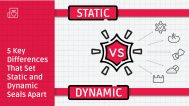The type of o-ring used in a given application depends on the surface it comes in contact with. The surface can either be dynamic, meaning in motion, or static, meaning without movement. If there is no movement between the mating surfaces, static seals are used. Conversely, if there is movement between two mating surfaces, dynamic seals should be applied.
Aside from the basic distinctions between these two types of seals, there are other major differences that have an impact on seal design. Here’s a closer look at what sets these seals apart.
1. Material Selection:
Static Seals: Since they are in a motionless environment, lower durometer materials can be used for low-pressure sealing. Lower abrasion resistance materials like silicone can be used to meet wider temperature ranges.
Dynamic Seals: Constant motion requires materials with high abrasion resistance and strength. Hydrogenated Nitrile with high abrasion resistance and low friction compounds like FKM rubbers or self-lubricating materials work well. Higher durometers are better for lower friction forces.
2. Maintenance Requirements:
Static Seals: Installed in motionless environments, they generally last longer, provided the right material is selected for chemical and temperature resistance.
Dynamic Seals: Exposed to movement and friction, they have a shorter lifespan and require more frequent maintenance to prevent premature failure.
3. Gland Design:
Static Seals: Cross-sections are generally compressed from 10% to 40%. Higher compression can be tolerated due to lack of movement.
Dynamic Seals: Gland design is crucial to avoid premature wear. The material of the gland should not abrade the o-ring during motion, and surface finishes must be compatible to prevent tears and failures. Cross-sections are compressed from 10% to only 30%.
4. Tolerance to Misalignment:
Static Seals: Typically more forgiving of misalignment between mating surfaces due to the lack of continuous movement. Static seals can accommodate slight deviations in alignment without significantly compromising their effectiveness.
Dynamic Seals: Misalignment can have a more pronounced impact on dynamic seals since they are subjected to constant motion. Tight tolerances are often crucial in dynamic applications to prevent wear, friction, and potential seal failure.
5. Heat Generation:
Static Seals: In applications where heat generation is minimal or intermittent, static seals may be more suitable. The absence of continuous motion reduces the heat generated during operation.
Dynamic Seals: Constant movement can lead to heat buildup due to friction between mating surfaces. Dynamic seals, therefore, must be designed to dissipate heat efficiently to prevent overheating, which can affect both the seal material and overall system performance.
Ready to learn more about static and dynamic seals?
Contact one of our engineers today.
